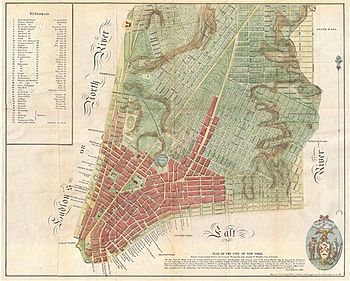Casimir Goerck
[2] Goerck was of Polish or German origin, and had come to America to be an artillery officer for the Continental Army in the American Revolution.
Despite the difficulty of the task due to the topography and ground cover, as well as the relatively primitive tools available to surveyors at the time, Goerck finished the job in about 6 months, by December 1785.
[4] In 1788, Goerck was hired by the long-established Bayard family, relatives of Peter Stuyvesant, to survey and lay out streets in the portion of their estate west of Broadway, so the land could be sold in lots.
[5] By 1794, with the economy of the city improving and hoping for increased sales of Common Lands lots, the Council again hired Goerck to survey the area.
In 1808, John Hunn, the city's street commissioner at the time, would comment that "The Surveys made by Mr. Goerck upon the Commons were effected through thickets and swamps, and over rocks and hills where it was almost impossible to produce accuracy of mensuration."
The New York City Landmarks Preservation Commission has written that "The Commissioner's Plan borrowed heavily from Goerck's earlier surveys and essentially expanded his scheme beyond the common lands to encompass the entire island.
Casimir Goerck, who spent long hours tramping the filthy streets, foul docksides, and swampy outskirts, was among them, early in the month.
